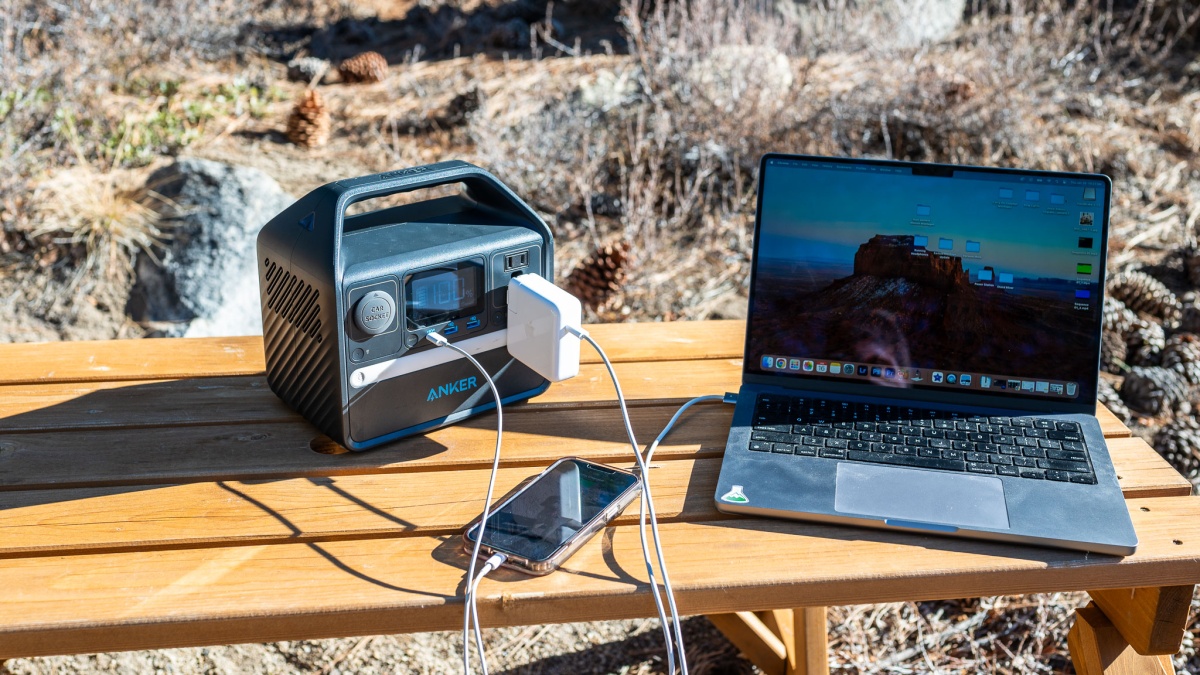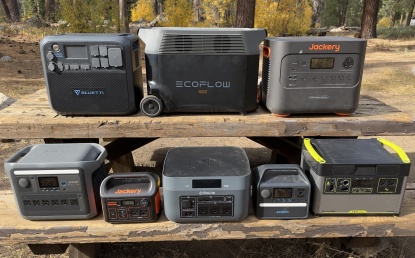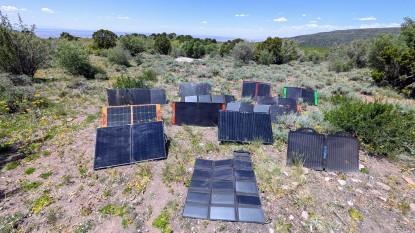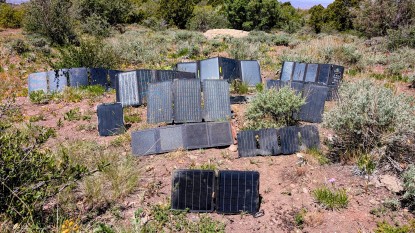How to Choose a Portable Power Station
Before deciding on a portable power station, there are a few key factors to consider.
Consider The Battery Capacity
One of the first steps for choosing the right power station is determining how much battery storage you need. This is most often referred to as the battery capacity in watt-hours. Theoretically, this means a 500Wh power station can output 500 watts for one hour. As we'll discuss, the nuances of power stations mean we don't quite get the full advertised capacity.
| Claimed Capacity | Usable % | Measured AC Capacity | Power Output Rating | |
|---|---|---|---|---|
| EcoFlow Delta Pro | 3,600 wh | 82% | 2,950 Wh | |
| Jackery 2000 Plus | 2,043 wh | 85% | 1,740 Wh | |
| Jackery 2000 v2 | 2,042 wh | 84% | 1,710 Wh | |
| Goal Zero Yeti 1500X | 1,516 wh | 86% | 1,300 Wh | |
| BioLite 1500 | 1,521 wh | 74% | 1,125 Wh | |
| Anker Solix C1000 | 1,056 wh | 81% | 860 Wh | |
| Jackery 300 | 293 wh | 89% | 260 Wh | |
| Anker 521 | 256 wh | 75% | 192 Wh |
We recommend jotting down each device you plan to use and determining how many watt-hours it will consume. Suppose you need to charge your laptop, and it consumes 50 watts. A 500Wh battery would recharge your laptop ten times. In a perfect world, the advertised capacity would be one hundred percent accurate, but we do not actually get to use the full amount of watt-hours advertised. This is because power stations need to have enough available capacity to continue to power aspects such as the AC inverter, the digital screen, and the fan operation, to name a few. When discharged all the way to zero, this ensures the power station will still have enough battery to recharge without killing the battery. As a buffer, we recommend at least a 20% margin in battery capacity. That means a 500Wh power station will have closer to 400Wh available.
How Many Watts Do You Need?
Some power stations are meant for charging small accessories and electronics, while others can be full-home backup solutions. Finding the right size power station is largely determined by the amount of wattage you'll require. The inverter on your power station converts direct current (DC) to alternating current (AC) and is rated by constant capacity and surge capacity. Appliances with high initial electrical current, such as a table saw, will have a large surge wattage when first starting. Think of it like riding a bike. When you first get going, the effort required to start pedaling takes much more than when at cruising speed.
| Maximum Wattage Supported | Four LED Lights (20W) | CPAP (60W) | Home Refrigerator (600W) | Hot Water Kettle (1,500W) | Space Heater (1,500W) | Induction Stove Burner (1,800W) | |
|---|---|---|---|---|---|---|---|
| EcoFlow Delta Pro | 3,600 watts | 148 hr | 49 hr | 14.8 hr | 2.0 hr | 2.0 hr | 1.6 hr |
| Jackery 2000 Plus | 3,000 watts | 87 hr | 29 hr | 8.7 hr | 1.2 hr | 1.2 hr | 1.0 hr |
| Jackery 2000 v2 | 2,200 watts | 86 hr | 29 hr | 8.6 hr | 1.1 hr | 1.1 hr | 1.0 hr |
| Goal Zero Yeti 1500X | 2,000 watts | 65 hr | 22 hr | 6.5 hr | 0.9 hr | 0.9 hr | 0.7 hr |
| BioLite 1500 | 1,200 watts | 56 hr | 19 hr | 5.6 hr | ✖ | ✖ | ✖ |
| Anker Solix C1000 | 1,800 watts | 43 hr | 14 hr | 4.3 hr | 0.6 hr | 0.6 hr | 0.5 hr |
| Jackery 300 | 300 watts | 13 hr | 4 hr | ✖ | ✖ | ✖ | ✖ |
| Anker 521 | 200 watts | 10 hr | 3 hr | ✖ | ✖ | ✖ | ✖ |
Smaller units in the 100-500 watt range are ideal for charging phones and laptops or running a few lights. Medium-sized units with inverters rated up to 1500 watts provide enough power to run appliances like coffee makers and refrigerators while often still being portable enough for a weekend camping trip or tailgate.
| Claimed Capacity | Usable % | Measured AC Capacity | Power Output Rating | |
|---|---|---|---|---|
| EcoFlow Delta Pro | 3,600 wh | 82% | 2,950 Wh | |
| Jackery 2000 Plus | 2,043 wh | 85% | 1,740 Wh | |
| Jackery 2000 v2 | 2,042 wh | 84% | 1,710 Wh | |
| Goal Zero Yeti 1500X | 1,516 wh | 86% | 1,300 Wh | |
| BioLite 1500 | 1,521 wh | 74% | 1,125 Wh | |
| Anker Solix C1000 | 1,056 wh | 81% | 860 Wh | |
| Jackery 300 | 293 wh | 89% | 260 Wh | |
| Anker 521 | 256 wh | 75% | 192 Wh |
Larger-sized power stations have inverters up to 3000 watts or more and are generally reserved for high-power uses such as AC units and high surge power tools. These units will also have enough battery capacity for extended use, say during a power outage or for off-grid living. Ideally, you should consider your wattage needs by determining what appliances and devices you need to be powered and for how long. Also, consider the total wattage you will need with multiple devices plugged in at the same time. This will give you a good starting point for narrowing down appropriately sized options.
What about Charging?
Charging speeds between different models and manufacturers can vary significantly due to the battery chemistry and the difference in wattage for each brand's wall charging unit. Some units are capable of fully recharging through AC in under an hour, while others can take over fourteen hours to reach a full charge. Folks with specific charging needs, such as those using their power stations for construction work, will benefit from a quicker recharge between jobs. If fast charging speed is important for you, consider options with a higher AC input. Also, if you plan on utilizing solar recharging, consider options that provide plenty of solar input. Most power stations are also equipped with custom charge settings between eco/slow and the ability to charge to a certain percentage. Some models also have ultra-fast charge settings, which come in handy for last-minute recharges, although this will cause more wear on your battery if used consistently. Ultimately, consider the type of applications you need your power station for and if a faster recharge is worth prioritizing.
| Measured Time to Charge | Claimed Battery Capacity | Measured Charging Speed | Charging Speed Rating | |
|---|---|---|---|---|
| EcoFlow Delta Pro | 2.6 hr | 3,600 Wh | 1,412 Wh/hr | |
| Jackery 2000 Plus | 1.6 hr | 2,043 Wh | 1,290 Wh/hr | |
| Jackery 2000 v2 | 2.5 hr | 2,042 Wh | 817 Wh/hr | |
| Anker Solix C1000 | 1.4 hr | 1,056 Wh | 763 Wh/hr | |
| BioLite 1500 | 12.8 hr | 1,521 Wh | 119 Wh/hr | |
| Goal Zero Yeti 1500X | 13.4 hr | 1,516 Wh | 113 Wh/hr | |
| Jackery 300 | 4.0 hr | 293 Wh | 74 Wh/hr | |
| Anker 521 | 4.1 hr | 256 Wh | 62 Wh/hr |
Battery Chemistry
Almost all portable power stations utilize lithium-ion batteries, but a couple of different chemistries are used between brands and models. Many companies are shifting their designs towards lithium iron phosphate (LiFePO4) battery chemistry because it's safer, has a longer lifespan, and has less thermal runaway. You may also commonly see nickel manganese cobalt (NMC) used in power stations. NMC does have a higher energy density, which allows for smaller, more compact designs. Typically, we recommend steering towards LiFePO4 because of its longer lifespan and more stable chemistry, but NMC batteries from a reputable brand are plenty safe. While battery chemistry is an important consideration, if a specific power station checks off all the right boxes but you're unsure of the battery chemistry, consider whether the longer lifespan is necessary or not. NMC batteries with shorter cycles will still last plenty long for off-grid camping, during emergencies, or for occasional power tool use. Unless you need to cycle your power station continually, such as those relying on their power station for full-time RV/van use, NMC batteries can still be a viable option.
Adding Solar Panels?
Almost all power stations are compatible with some kind of solar panel, and most brands sell solar panels custom-designed to work with their power stations.
Solar panels are a great option to complement a power station if you want to use your power station for multiple days without access to an AC outlet. While your daily use of power may drain much of your power station's charge %, if the sun is out, solar panels enable you to potentially top it off to full charge each sunny day. Solar panels are great for off-grid camping trips of 3 days or more, or during a multi-day power outage. If you get enough solar panels to fully recharge each day, you can have power for as many days as the sun is shining.
How Much Solar Watts Will You Need?
You might think that a 200 watt solar panel is more than enough to fully charge at 1,000 Wh power station each day, since 5 hours of sun should, in theory, produce 1000 watts-hours of power (200w x 5hrs = 1,000 Wh). Turns out it isn't that simple.
There are two factors to be aware of that will impact how much you can charge each day:- Assume 80% Efficiency — no solar panels are 100% efficient at charging a power station. Many people suggest 75% efficiency is a good rule of thumb for solar panel efficiency. The best solar panels we've tested deliver about 85% efficiency (and the worst offer less than 60% efficiency). Assuming you buy one of the more efficient panels, we'll use 80% efficiency in our calculations. Refer to our detailed tests of solar panels for power stations for more info.
- Assume 4-6 Peak Sun Hours Per Day — solar charging mostly occurs during “peak sun hours,” when the sun is higher in the sky and shining more directly down. Cloud cover and obstructions like trees also present challenges. If you are camping in the desert, you might be able to count on a lot more peak sun hours each day, but 4-6 hours is a good rule of thumb.
| Solar Panel Watts | 300 Wh Power Station | 1,000 Wh Power Station | 2,000 Wh Power Station | 3,000 Wh Power Station | 4,000 Wh Power Station |
|---|---|---|---|---|---|
| 100W Panel | 3.8 hr | 12.5 hr | ✖ | ✖ | ✖ |
| 200W Panel | ✖ | 6.3 hr | 12.5 hr | ✖ | ✖ |
| (2) x 200W Panels | ✖ | 3.1 hr | 6.3 hr | 9.4 hr | 12.5 hr |
| 500W Panel | ✖ | 2.5 hr | 5.0 hr | 7.5 hr | 10.0 hr |
| (2) x 500W Panels | ✖ | 1.3 hr | 2.5 hr | 3.8 hr | 5.0 hr |
Minimum of 200 watts Solar per 1,000 Wh Power Capacity. A reasonable strategy is to obtain a 200 watt solar panel, and see how it goes. With a 200 watt solar panel you'll need 6.3 hours of peak sun each day to fully charge each 1,000 Wh of power station capacity (200W x 6.3 hrs x 0.8 = 1,008). But, most people are not using 100% of their battery power each day, so if you only draw down on a typical day to 40% of a 1,000 Wh capacity power station, then a 200 watt panel can top you off each day with just 2.5 hours of peak sun.
How to use 200 watt solar to extend your power duration on a 3-day weekend camping trip. Let's say you have a 2,000 Wh capacity power station, and you are heading for a family off-grid camping trip where you arrive on Friday afternoon and head back home on Sunday afternoon. The weather forecast is sunny and clear skies. You expect to use 20% of the battery capacity (400 Wh) on Friday afternoon and evening, then 80% of capacity on Saturday (1600 Wh), and another 30% on Sunday (600 Wh). That adds up to 2,600 Wh of power, which is more than your 2,000 Wh capacity.
Will a single 200 watt solar panel get you through it?
The answer is quite likely.
Here's the math…- Fully charged on Friday — Let's assume you arrive with your 2,000 Wh power station fully charged on Friday afternoon
- Friday is a no solar power day — You arrive in the afternoon and set up your solar panel right away, but since you are already fully charged, that late afternoon sun solar power doesn't matter. You probably don't start using significant power until near sundown, and the sun is too low to do much solar charging by that time. Let's assume negligible solar charging on Friday. You don't use a huge amount of power on Friday night — just LED lights and the electric cooler, and recharging some devices overnight. You bust out the outdoor projector for a movie night for the kids (the projector has batteries that cover you for Friday's show). Friday night's usage takes you down to 80% battery capacity.
- Saturday is the crux day and you start at 80% capacity — you have 80% capacity or 1,600 Wh available on Saturday morning. You are going to use an estimated 1,600 Wh on Saturday, which is all you have available. This is your big power day; you use more power on Saturday than any other day between breakfast, dinner, and your super-cool electric camping set up that includes LED string lights, electric cooler for 24 hours, recharging 2 phones + 2 iPads + 2 laptops, and the outdoor movie projector for the kids (which needs power since the projector batteries were mostly drained on Friday night). But, your 200 watt solar panel is set up and gets you through the day, providing 800 Wh of charging (200w x 5 hrs x 0.8 efficiency = 800 watt-hours). You end the day with 800 Wh available (40% capacity).
- Sunday is a low power day — you wake up with 800 Wh, or 40% capacity, on your 2,000 Wh power station. Your main power needs on Sunday are for breakfast, and you have more than enough. By the time you pack up and head home on Sunday, you still have more than 10% of capacity left, likely more than 20%.
One Solar Panel or Two?
We recommend starting with one solar panel, and for most people, that will be a 200-watt solar panel, and just see how it goes. If you find you need more recharging capability, then buy a second 200-watt panel. Our recommendation is that only those folks who know from experience that they require much more power need to consider stepping up to 500-watt solar panels.
In our experience with electric off-grid camping, we quickly learned that there are two things we love for off-grid camping, but are worth thinking twice about because they significantly increase your power needs:
- Electric cooking — we love cooking on an electric induction stovetop, which is efficient, involves no fuel exhaust, and lets us precisely dial in the right amount of heat. But, if you are cooking for a group, on two 1,500-watt stovetops, you are going to chew through a lot of your battery capacity. An hour of cooking on a single 1,500-watt stovetop at full blast is going to use 1,500 Wh of power, draining most of the actual available power output from your 2,000 Wh power station. The power requirements of all-electric cooking are high enough to raise the question of whether it's worth it. Staying with an old-school camping stove until the battery tech gets a lot better will help you avoid being anxious about burning through all your remaining battery capacity to cook that gourmet meal, or worse, waking up with insufficient power to make your morning coffee! We are happy to continue using our old, yet reliable, camping stove for the time being, so we can fully enjoy all the other benefits of an off-grid, electric-powered campsite.
- eBike charging --charging your eBike fully from 0 to 100% requires around 1,000 Wh, which is probably more than half of your 2,000 Wh power station's actual measured power output. The good news is that most people typically do not fully deplete their eBike battery every day. If you just need to top off eBike batteries each day, your power station should be able to handle that. FYI, we still bring our eBikes off-grid camping, but we bring two 200W solar panels to boost our recharging capability!
Brand Solar Panels vs. DIY Solutions
The simplest and easiest way to add solar panels is to buy solar panels from the same brand manufacturer of your power station. That ensures compatibility and that you get the right cables to connect it up.
But, many people take a DIY approach and buy solar panels off of Amazon, making sure they figure out which size watts panel will be compatible with their power station, and then obtain (or even make) your own cables to connect them to your power station. The risks of a DIY approach is that you are on your own if something goes wrong, and you may void your warranty.
Most people will be wise to stay with a solar panel from the same brand as your power station, and we find those options to be reasonably priced, and importantly, quite easy to use.



